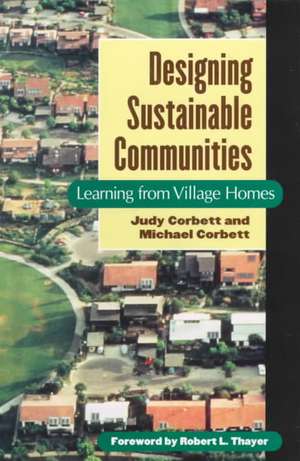Designing Sustainable Communities: Learning From Village Homes
Autor Michael Corbett, Judy Corbett Cuvânt înainte de Robert L. Thayeren Limba Engleză Paperback – dec 1999
The movement toward creating more sustainable communities has been growing for decades, and in recent years has gained new prominence with the increasing visibility of planning approaches such as the New Urbanism. Yet there are few examples of successful and time-tested sustainable communities.
Village Homes outside of Davis, California offers one such example. Built between 1975 and 1981 on 60 acres of land, it offers unique features including extensive common areas and green space; community gardens, orchards, and vineyards; narrow streets; pedestrian and bike paths; solar homes; and an innovative ecological drainage system. Authors Judy and Michael Corbett were intimately involved with the design, development, and building of Village Homes, and have resided there since 1977.
In Designing Sustainable Communities, they examine the history of the sustainable community movement and discuss how Village Homes fits into the context of that movement. They offer an inside look at the development of the project from start to finish, describing how the project came about, obstacles that needed to be overcome, design approaches they took, problems that were encountered and how those problems were solved, and changes that have occurred over the years. In addition, they compare Village Homes with other communities and developments across the country, and discuss the future prospects for the continued growth of the sustainable communities movement.
The book offers detailed information on a holistic approach to designing and building successful communities. It represents an invaluable guide for professionals and students involved with planning, architecture, development, and landscape architecture, and for anyone interested increating more sustainable communities.
Village Homes outside of Davis, California offers one such example. Built between 1975 and 1981 on 60 acres of land, it offers unique features including extensive common areas and green space; community gardens, orchards, and vineyards; narrow streets; pedestrian and bike paths; solar homes; and an innovative ecological drainage system. Authors Judy and Michael Corbett were intimately involved with the design, development, and building of Village Homes, and have resided there since 1977.
In Designing Sustainable Communities, they examine the history of the sustainable community movement and discuss how Village Homes fits into the context of that movement. They offer an inside look at the development of the project from start to finish, describing how the project came about, obstacles that needed to be overcome, design approaches they took, problems that were encountered and how those problems were solved, and changes that have occurred over the years. In addition, they compare Village Homes with other communities and developments across the country, and discuss the future prospects for the continued growth of the sustainable communities movement.
The book offers detailed information on a holistic approach to designing and building successful communities. It represents an invaluable guide for professionals and students involved with planning, architecture, development, and landscape architecture, and for anyone interested increating more sustainable communities.
Preț: 216.39 lei
Nou
Puncte Express: 325
Preț estimativ în valută:
41.41€ • 44.28$ • 34.52£
41.41€ • 44.28$ • 34.52£
Carte indisponibilă temporar
Doresc să fiu notificat când acest titlu va fi disponibil:
Se trimite...
Preluare comenzi: 021 569.72.76
Specificații
ISBN-13: 9781559636865
ISBN-10: 1559636866
Pagini: 254
Dimensiuni: 152 x 229 x 20 mm
Greutate: 0.43 kg
Ediția:None
Editura: Island Press
Colecția Island Press
ISBN-10: 1559636866
Pagini: 254
Dimensiuni: 152 x 229 x 20 mm
Greutate: 0.43 kg
Ediția:None
Editura: Island Press
Colecția Island Press
Cuprins
Foreword
Preface
Acknowledgments
Chapter 1. From Piecemeal Planning to Sustainable Development
Chapter 2. An Introduction to Village Homes
Chapter 3. The Basis for Sustainable Development
Chapter 4. Water, Food, Shelter: The Basics
Chapter 5. Society's Lifeblood: Energy
Chapter 6. The Use of Resources in Sustainable Design
Chapter 7. Location, Size, and Density
Chapter 8. Designing with Nature for People: A Sustainable Approach to Urban Design
Chapter 9. The Process of Creating Sustainable Communities,
Chapter 10. The Garden City: Case Studies of Sustainable Development in Practice
Notes
Index
Preface
Acknowledgments
Chapter 1. From Piecemeal Planning to Sustainable Development
Chapter 2. An Introduction to Village Homes
Chapter 3. The Basis for Sustainable Development
Chapter 4. Water, Food, Shelter: The Basics
Chapter 5. Society's Lifeblood: Energy
Chapter 6. The Use of Resources in Sustainable Design
Chapter 7. Location, Size, and Density
Chapter 8. Designing with Nature for People: A Sustainable Approach to Urban Design
Chapter 9. The Process of Creating Sustainable Communities,
Chapter 10. The Garden City: Case Studies of Sustainable Development in Practice
Notes
Index
